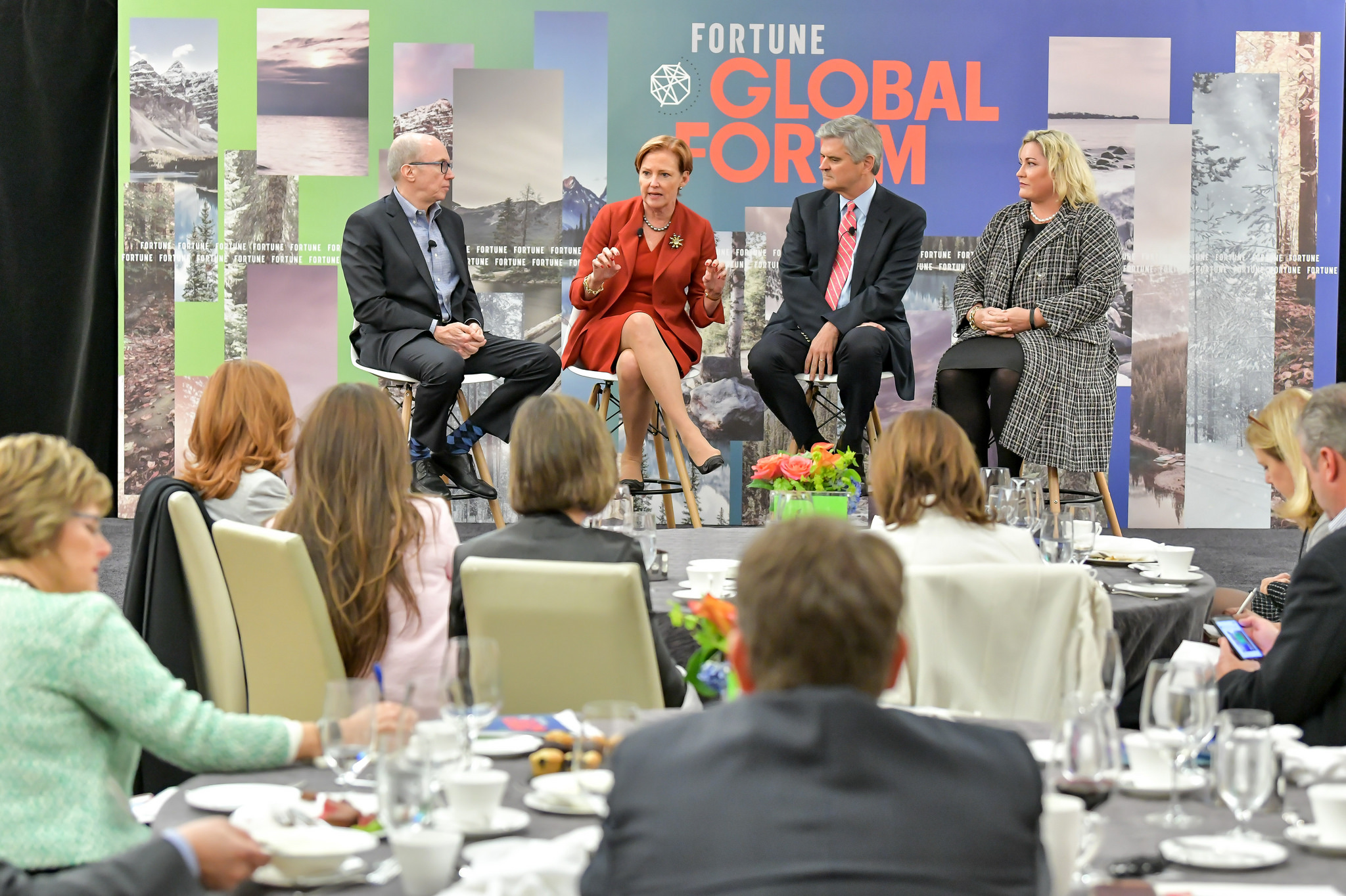
|
如果想打造创新文化,就不能再继续捧着那些曾经创造辉煌的人和产品不放了——大公司尤其如此。有明确的公司使命,也能对创新有所帮助。 这是2018年加拿大多伦多财富全球论坛上的一些重要结论。在论坛的一个环节中,三位现任和离任CEO热烈讨论了这一议题:大公司的设计旨在求稳,而非通过创新开拓新市场。 杜邦前任总裁兼CEO柯爱伦抛出问题:“你如何看待失败?如何从失败中学习怎么做得更好?” Revolution公司的总裁兼CEO史蒂夫·凯斯沉吟片刻,回忆了他掌管美国在线(AOL)时公司2000年以1650亿美元传奇般地收购了时代华纳之后的经历。时至今日,这仍然是史上最大规模的并购,然而,“现在也是史上最失败的并购,这事会刻进我的墓志铭。”他说。 他将失败归咎于文化冲突,并购后这个数字行业的初创企业慢慢变成了一家要保护传统资产的大型媒体公司。“创业家思维是‘攻占山头’,”他说。“但在并购后,我意识到[被收购的公司]思维方式不同,他们更关注短期表现、避免犯错,而当今世界最大的错误就是不敢冒险。” “当你需要保持现有产品增长,维持稳定收入时,的确会产生惰性。”半导体初创企业Ampere Computing的总裁兼CEO詹睿妮说。但这位前英特尔总裁表示,如果小团队得到了合适的投资,会自然而然地追求更宏大的愿景,他们可以打破这种僵化的局面。“有明确的公司使命对于创新十分重要,”她说。“你想解决什么问题?你想如何改变世界?” 她开玩笑说,零食确实能激励团队,但是,让公司上下团结一致,不断尝试,取得成果才是关键所在。 “要打造明确的企业文化,[宣布]目标,确定衡量指标,”詹睿妮说。“让公司上上下下都知道我们想要实现什么。”这样,每个人的福利都取决于每一季度的工作成果,清清楚楚。“每个人都将因为那个[目标]得到回报。” 柯爱伦分享了杜邦早期面临的生死存亡危机,那时还是20世纪20年代。 “我们最初是家炸药公司。我们还是家庞大而僵化的公司。”她说。为了推动创新,他们聘用了20世纪20年代版本的千禧一代,他们询问这些从事销售和市场营销的年轻人,杜邦应当如何拥抱新的机遇,因为这些年轻人了解正在变化的市场。这个年轻的团队将杜邦重新定义为矩阵式结构组织,避免人们在原有工作流程下,新想法还没有摆到董事会的桌上就已经被扼杀了。该团队还在组织内部实现了创新责任的重新分布。“从此之后,我们在每一个曾经经营的业务领域都进行发明,创造了新的产品类别。”她说。“我们要不断发明,不然就会被淘汰。” 在Revolution公司,凯斯正在全国范围内寻找具有创新精神的创业公司,尤其是在传统投资领域覆盖范围之外的公司;寻找在合适的条件下可以与大公司开展合作的创业公司。 对于这些公司而言,资金是个问题。“去年75%的风投资金流向了三个州,加州、纽约和马萨诸塞州。但并非所有高增长的创业公司都在那里。”他说。 所有人都认同文化变革必须是刻意为之的重塑过程。“随着公司规模变大,那些小尝试就不复存在了。”凯斯说。 为了找回那些小尝试,你要确保人们已经准备好采取不一样的运营模式了。“企业的文化模式和文化图腾源自企业内部,”柯爱伦说。“要让中层领导对跳出舒适圈感到习惯,这必须要成为企业文化的一部分。”(财富中文网) 译者:Agatha |
If you want to build a culture of innovation, you’re going to have to stop protecting the people and products that once made you great—especially if you’re a big company. Having a mission also helps. These are some of the big takeaways from the Fortune Global Forum 2018 in Toronto, Canada, as three current and former CEOs wrestled with the notion that big companies are more designed to play it safe, rather than innovate their way into new markets. “How do you honor failures and use those as learning tools to figure out how to do better?” asked Ellen Kullman, the former Chairman and CEO of DuPont. Steve Case, the Chairman and CEO of Revolution, took a moment to look reflect on his experience at the helm of AOL after their storied purchase of Time Warner for $165 billion in 2000. It remains the biggest merger in history, and yet, “now, the worst merger in history, which will go on my tombstone,” he says. He blames a culture clash as the digital start-up morphed into a massive media company with traditional assets to protect. “The entrepreneurial mindset is ‘take the hill,’” he said. “After the merger, I just realized there’s a different mindset [in the merged firm], much more about the short-term and avoiding mistakes, in a world where the biggest mistake is not taking enough risks.” “There’s a real inertia when you need to keep existing product growing and revenue stable,” says Renee James, Chairman and CEO of semiconductor start-up, Ampere Computing. But the former Intel president says that small teams, properly invested in, naturally respond to a big vision and can break the gridlock. “Mission is a big deal in innovation,” she says. “What problem do you want to solve? How do you want to change the world?” While snacks clearly help keep teams energized, she joked, aligning the entire company to the outcome of the experimental work is the real key, she says. We create a culture of clarity, [declare] a goal and say how we’re going to measure it,” says James. “And the whole company knows what we’re trying to do.” Then, everyone’s bonus is linked to four clear deliverables, reviewed every quarter. “Everyone is going to get paid on that [goal].” Kulman shared one of DuPont’s earliest grow or die moments—in the 1920s. “We began as an explosives company. We were also a monolithic organization,” she says. To create an innovation pipeline, they tapped the 1920s version of millennials, the young people in sales and marketing who understood the changing marketplace and asked them how DuPont could respond to new opportunities. The team reimagined DuPont as a matrix organization which helped people work around the processes that were killing ideas before they were ever considered for investment by the board. It also helped re-distribute the responsibility for innovation throughout the organization. “We’ve since invented every category we’ve operated in,” she says. “We have to keep inventing or we’re not going to be around.” At Revolution, Case is now seeking innovative start-ups across the country, in communities firmly outside of traditional venture circles; the types of companies that, under the right circumstances, could be a partner of a larger firm. For these companies, cash is the problem. “Seventy-five percent of venture capital went to three states last year, California, New York, and Massachusetts. Not every high growth start-up is there,” he says. All agree that culture change has to be an intentional act of reinvention. “As companies get bigger, the little experiments go away,” says Case. To bring them back, you’ll have to make sure people are ready to operate differently. “Culture norms, totems, are set in the middle of the company,” says Kullman. “Making sure those middle leaders are comfortable with the uncomfortable has to become part of the culture.” |






